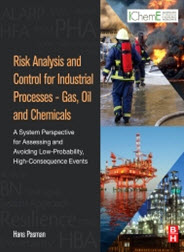 Book reviews
Book reviews-
Risk Analysis and Control for Industrial Processes- Gas, Oil and Chemicals: A System Perspective for Assessing and Avoiding Low-Probability, High-Consequence Events
Publisher
: Elsevier B.V., Amsterdam
Title
: Risk Analysis and Control for Industrial Processes- Gas, Oil and Chemicals: A System Perspective for Assessing and Avoiding Low-Probability, High-Consequence Events
Author Hans Pasman Year of Publication
: 2015
Pages
: 474
ISBN
: 978-0-12-800057-1
Reviewer
: Krishna B. Misra
Status
: Review Complete
The book comprises 13 chapters, preceded by a Foreword, Preface and Acknowledgements.
Chapter 1
Industrial Processing Systems, their Products and Hazards
31 Pages
Chapter 2
Regulation to Safeguard against High-Consequences Industrial Events
46 Pages
Chapter 3
Loss Prevention History and Developed Methods and Tools
106 Pages
Chapter 4
Trends in Society and Characteristics of Recent Industrial Disasters
29 Pages
Chapter 5
Sociotechnical Systems, System Safety, Resilience Engineering, and Deeper Accident Analysis
26 Pages
Chapter 6
Human Factors, Safety Culture, Management Influences, Pressures, and More
43 Pages
Chapter 7
New and Improved Process and Plant Risk and Resilience Analysis Tools
70 Pages
Chapter 8
Extended Process Control, Operator Situation Awareness, Alarm Management
27 Pages
Chapter 9
Costs of Accidents, Costs of Safety, Risk-based Economic Decision Making: Risk Management
24 Pages
Chapter 10
Goal-oriented versus Prescriptive Regulation
09 Pages
Chapter 11
The Improved Role of Knowledge and Learning
13 Pages
Chapter 12
Risk, Risk Perception, Risk Communication, Risk Acceptance: Risk Governance
24 Pages
Chapter 13
Conclusions: The Way Ahead
06 Pages
Index
14 Pages
This book is about low probability and high risk hazardous events such as have occurred in nuclear, chemical
 process industries including petrochemicals, off-shore gas and oil exploration, in the past and discusses how such events can be identified and analyzed to prevent their occurrences.
process industries including petrochemicals, off-shore gas and oil exploration, in the past and discusses how such events can be identified and analyzed to prevent their occurrences.The book uses systems approach in presenting safety tools and techniques besides providing a history of such disaster from the past. The book provides in-depth information to identify potential issues and methodology to assess the likelihood of occurrences of hazardous events. Costs of accidents, costs of safety and risk based economic decisions find place in the book in order to carry out capital and operating costs of preventive measures against the benefits of safety improvement.
Human factors and safety culture and human attitude have also been discussed and how these can be accounted for in developing safety regulations. New approaches such as system-theoretic process analysis, Blended HAZID, Bayesian Nets and fuzzy sets are also presented. The book is replete with several examples and case studies. The author of this book is Research Professor at Mary Kay O’Connor Process Safety Center at Texas A&M University and Emeritus Professor Chemical Risk Management of the Delft University of Technology in the Netherlands. He has been member and chairman of the EFCE Working Party on Loss Prevention and Safety Promotion in the Process Industries and was instrumental in founding the European Process Safety Centre in 1992.
This book makes an interesting reading for all engineers who deal with risk assessment and management of industrial processes. The case studies presented are wide-ranging, informative and worth knowing for a safety engineer. This book is useful to engineering graduates and managers and designers and plant engineers.
This review has been published in Vol. 11, No. 6, November 2015 issue of the IJPE

